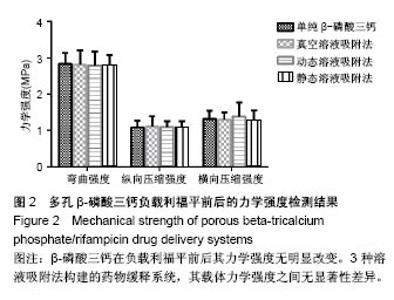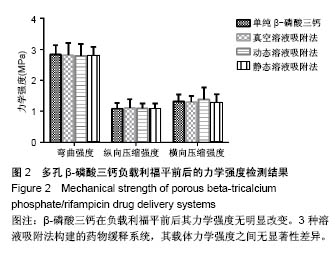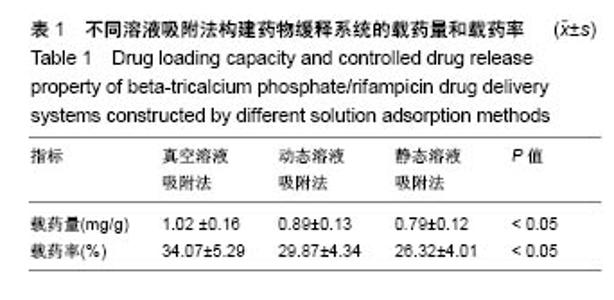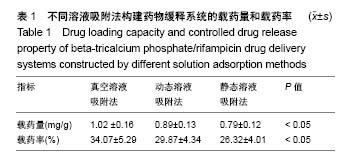| [1] Kandwal P, G V, Jayaswal A. Management of tuberculous infection of the spine. Asian Spine J. 2016;10(4):792-800.[2] 孙伟,赵杰,郭开今,等.富集骨髓间充质干细胞用于兔腰椎横突间的融合[J].中国组织工程研究, 2012,16(10):1752-1755.[3] 费正奇,胡藴玉.抗骨结核缓释药物:载体材料的选择[J].中国组织工程研究, 2015,19(21):3387-3391.[4] 黄术,张宏其,刘保荣等.新型抗结核缓释体的骨密度初步试验研究[J].中国医师杂志,2014;2:218-220.[5] Huang D, Li D, Wang T, et al. Isoniazid conjugated poly(lactide-co- glycolide): long-term controlled drug release and tissue regeneration for bone tuberculosis therapy. Biomaterials. 2015;52:417-425.[6] Mura S, Nicolas J, Couvreur P. Stimuli-responsive nanocarriers for drug delivery. Nat Mater. 2013; 12(11): 991-1003. [7] Zhang G, Zeng X, Li P. Nanomaterials in cancer-therapy drug delivery system. J Biomed Nanotechnol . 2013; 9(5): 741-750. [8] Lorenz J, Barbeck M, Kirkpatrick CJ, et al. Injectable bone substitute material on the basis of β-TCP and hyaluronan achieves complete bone regeneration while undergoing nearly complete degradation. Int J Oral Maxillofac Implants. 2018;33(3):636-644. [9] Sakata M, Tonomura H, Itsuji T, et al. Bone regeneration of osteoporotic vertebral body defects using platelet-rich plasma and gelatin β-tricalcium phosphate sponges. Tissue Eng Part A. 2018;24(11-12):1001-1010.[10] Liu X, Zhang Y, Xiong K, et al. Fabrication of a novel beta tricalcium phosphate/sodium alginate/poly(D,L-lactic acid) composite microsphere and its drug releasing property. J Nanosci Nanotechnol. 2018;18(6):3844-3849.[11] 袁君杰,谢幼专.药物缓释载体负载药物方法的研究[J].生命科学, 2013, 25(3): 329-333.[12] Zhu M, Wang H, Liu J, et al. A mesoporous silica nanoparticulate/ β-TCP/BG composite drug delivery system for osteoarticular tuberculosis therapy. Biomaterials. 2011;32(7):1986-1995.[13] Guo YP, Guo LH, Yao YB, et al. Magnetic mesoporous carbonated hydroxyapatite microspheres with hierarchical nanostructure for drug delivery systems. Chem Commun (Camb). 2011; 47(44):12215-12217.[14] Zhu M, Li K, Zhu Y,et al. 3D-printed hierarchical scaffold for localized isoniazid/rifampin drug delivery and osteoarticular tuberculosistherapy. Acta Biomater. 2015;16:145-155.[15] Matsushita N, Terai H, Okada T, et al. A new bone-inducing biodegradable porous β-tricalcium phosphate. J Biomed Mater Res A. 2004; 70(3):450-458. [16] 吕静,叶盛英,王昊,等.负载抗菌药物骨水泥的药物释放实验研究[J].生物骨科材料与临床研究,2017,14(6):7-10.[17] 毋育伟,陆慧,胡洪成,等.脂联素微球复合 PLGA/β-TCP 支架材料的制备及生物活性评价[J].实用口腔医学杂志, 2015, 31(5):615-618.[18] Chiang PC, Ran Y, Chou KJ, et al. Evaluation of drug load and polymer by using a 96-well plate vacuum dry system for amorphous solid dispersion drug delivery. AAPS PharmSciTech.2012;13(2):713-722.[19] Hoang Thi TH, Morel S, Ayouni F, et al. Development and evaluation of taste-masked drug for paediatric medicines-Application to acetaminophen. Int J Pharm.2012; 434(1):235-242.[20] Swarnakar NK, Jain AK, Singh RP, et al. Oral bioavailability, therapeutic efficacy and reactive oxygen species scavenging properties of coenzyme Q10-loaded polymeric nanoparticles. Biomaterials. 2011; 32(28):6860-6874.[21] 李昱,张占召,吴鼎宇,等. 包埋载辛伐他汀PLGA微球的胶原/壳聚糖支架的制备及其生物相容性研究[J].组织工程与重建外科杂志, 2017,13(2):61-65.[22] Zhang Y, Zhang Q, Sun J, et al. The combination therapy of salinomycin and gefitinib using poly(d,l-lactic-co-glycolic acid)-poly(ethylene glycol) nanoparticles for targeting both lung cancer stem cells and cancer cells. Onco Targets Ther.2017; 10:5653-5666.[23] Xiao FJ, Peng L, Zhang Y, et al. Silicon-substituted hydroxyapatite composite coating by using vacuum-plasma spraying and its interaction with human serum albumin. J Mater Sci Mater Med. 2009; 20(8): 1653-1658.[24] Mandeville JS, Bourassa P, Thomas TJ, et al. Biogenic and synthetic polyamines bind cationic dendrimers. PloS one. 2012; 7(4):e36087.[25] Barsoum BN, Kamel MS, Diab MM. Spectrophotometric determination of isoniazid and rifampicin from pharmaceutical preparations and biological fluids. Res J Agric Biol Sci. 2008; 4(5):471-484.[26] Zhang X, Wyss UP, Pichora D, et al. A mechanistic study of antibiotic release from biodegradable poly (d, l-lactide) cylinders. J Control Release. 1994; 31(2):129-144. [27] Dohzono S, Imai Y, Nakamura H, et al. Successful spinal fusion by E. coli-derived BMP-2-adsorbed porous beta-TCP granules: a pilot study. Clin Orthop Relat Res. 2009; 467(12):3206-3212.[28] Bemer-Melchior P, Bryskier A, Drugeon HB. Comparison of the in vitro activities of rifapentine and rifampicin against Mycobacterium tuberculosis complex. J Antimicrob Chemother. 2000; 46(4):571-576. |







